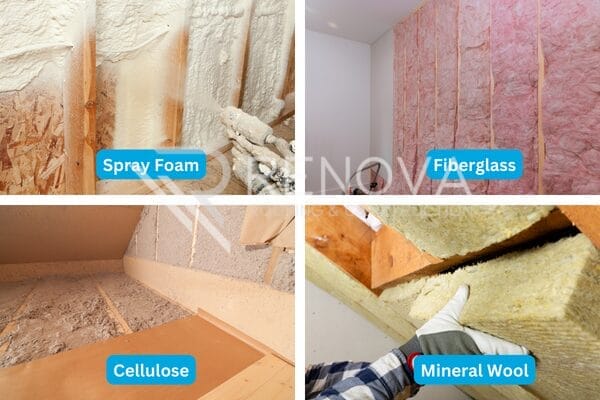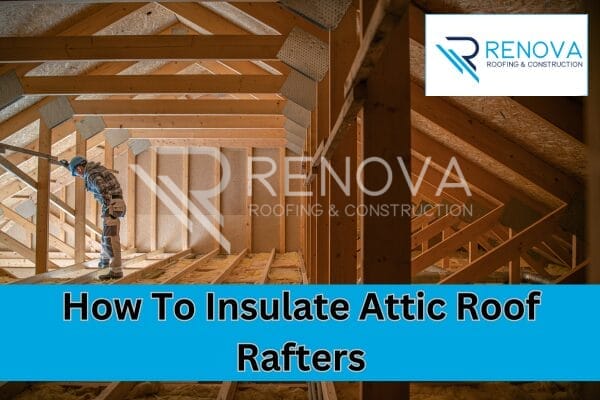Do you know what roof rafters are? While the roof protects your home, the rafters and trusses support the roofing system by providing a stable structure. But this is not the only purpose of rafters.
You can also insulate them to keep the temperature of your home comfortable and improve energy efficiency. But how do you do this? If you are wondering how to insulate attic roof rafters, you are in the right place. In this blog post, we will go over step-by-step how to insulate your attic roof rafters.
Let’s get started.
Step 1: Choose The Right Insulation Material
When insulating your attic roof rafters, selecting the right insulation material is crucial for energy efficiency and cost-effectiveness. Here are some top insulation materials that you can choose:

- Fiberglass: This is one of the most popular insulation materials due to its affordability and effectiveness. Fiberglass insulation comes in rolls or batts and is lightweight and easy to install between rafters.
- Cellulose: Made from recycled paper products, cellulose insulation is eco-friendly and offers good thermal performance. It can be blown into the attic using a machine. Cellulose insulation also has excellent sound-dampening properties.
- Spray Foam: This insulation type provides an air-tight seal and excellent thermal resistance. While more expensive, spray foam insulation effectively prevents air leaks and moisture buildup. It also expands to fill cavities, ensuring complete coverage.
- Mineral Wool: Mineral wool, made from natural rock or slag, is fire-resistant and provides good thermal and sound insulation. It comes in batts or loose-fill form and is also resistant to moisture and mold growth.
- Rigid Foam: Rigid foam boards offer high insulation values and are moisture-resistant. They are often used in combination with other insulation materials for added effectiveness. Rigid foam boards are also easy to cut and fit into irregular spaces.
If you want to learn more about these types of roofing insulation, read our guide: The 6 Best Types Of Roof Insulation (2024 Guide)
Step 2: Take Necessary Precautions
The first step in performing any roofing project, be it outside or inside, is to take the necessary precautions. There are two main things that you need to take into consideration before insulating your attic rafters. First is to make sure that you wear proper safety equipment. This can include wearing a mask, gloves, and protective glasses. Second, you should have all the right tools such as insulation materials, a utility knife, a tape measure, and compatible adhesives if necessary.
Make sure to clear the work area of any tripping hazards, tools, or debris that could hinder the installation.
Step 3: Reach and Inspect Your Attic
Once you’ve ensured your safety, it’s time to inspect your attic. Use a flashlight to inspect the rafters, walls, and existing insulation. Check for any signs of damage, such as leaks, cracks, or holes. Also, look for debris or pests that may have made their way into your attic. If you notice anything unusual, such as water stains or mold, it’s important to address these issues before you insulate your rafters and to prevent further damage to your home.
Step 4: Cut The Insulation
One of the most important steps in insulating attic roof rafters is ensuring a precise, snug fit for the insulation. Take careful measurements of each rafter cavity, noting the length between the exterior walls as well as the width between each set of rafters. With these measurements in hand, use a straight edge and utility knife to trim the insulation to the exact dimensions needed.
Cutting some types of insulation can create dust and microscopic debris, which is why protective wear is necessary.
Leave no gaps or spaces around the edges – the insulation should make full contact with the framing when inserted. For any irregular spaces or tight corners, don’t be afraid to cut and shape the material accordingly.
Step 5: Install The Insulation
Once you are within the reach of your rafters, it’s time to install the attic insulation. As we covered above, there are several types of roofing insulation and you will need to install it according to its specific requirements. For cellulose or spray foam, this may include using specialized equipment to blow the insulation between the rafters.
If you are unsure how to install the insulation, it is best to work with an experienced contractor. Unsuccessful DIY attempts can lead to attic damage and expensive repairs.
Benefits Of Attic Roof Rafter Insulation
Insulating the space between the rafters in your attic is one of the smartest home improvement projects you can undertake. If done correctly you can take advantage of the following benefits:
Improved Energy Efficiency
Heat loss through the roof accounts for a significant portion of home energy waste. Rafter insulation acts as a thermal blanket, preventing heated or cooled air from escaping. This lessens the workload on your HVAC system, leading to lower monthly utility bills.
Moisture and Condensation Control
Ventilated rafter insulation allows drier air to circulate, minimizing damaging moisture buildup. This prevents wood rot, mold growth, degraded insulation performance, and unsightly water stains on ceilings.
Can Utilize Extra Space
Properly insulating between the attic rafters doesn’t just improve energy efficiency – it can also open up new possibilities for usable living space in your home. When you insulate an attic with rafters, you are not using any additional space and the headroom remains the same. So you can convert an insulated attic into a living space, storage area, or even a home office, providing more functional space within the house.
Best Attic Insulation Services on the Gulf Coast
With these steps, you can easily insulate your attic roof rafters. But insulating roof rafters is not as easy as it sounds. If things go wrong, it will do more harm than good.
For professional insulation installation services, you can trust our experts at Renova Roofing & Construction. We offer the best residential roofing services in Mississippi, Louisiana, and Alabama.

